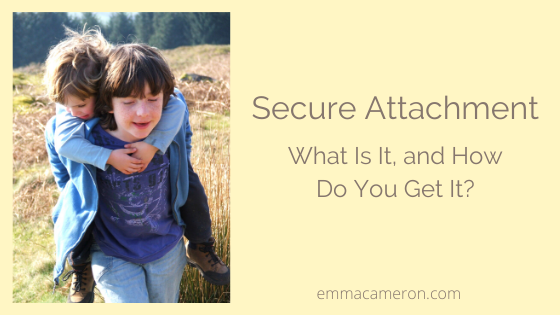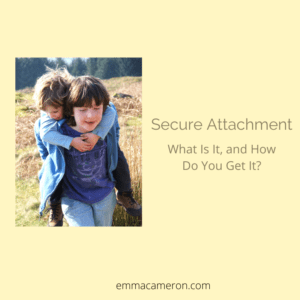
Secure Attachment
In my last blog post, ‘Attachment – A Beginner’s Guide’, I introduced the idea of attachment. Here, I’m going to explain a bit more about secure attachment. I’ll discuss some characteristics of people who are securely attached, and answer the all-important question: Is it possible to become securely attached, even if you didn’t start out that way?
Secure attachment is the attachment category we’d all want ourselves and our loved ones to be in. Some people are lucky enough to be raised in a context that allowed them to become securely attached. These people tend to grow up feeling fairly comfortable in their own skin, with satisfying relationships. They’re also able to engage in work or other activities that feel meaningful to them.
What Secure Attachment Feels Like
If you’re a securely attached person you’ll tend to have a nervous system that’s pretty calm a lot of the time. You will generally feel able to live, work and play in ways that feel satisfying. Securely attached folks generally have a sense that the world’s basically a benign place, mostly populated with trustworthy and potentially loveable people. You’ll know that there are others you can turn to in times of trouble, and on the whole you are in turn emotionally available for your loved ones.
When a securely attached person is under stress, they’re more likely to be able to think, feel and behave in flexible ways that can respond and adapt to specific situations (by contrast, insecurely attached people tend to get stuck in rather rigid patterns of thoughts, feelings and behaviours when they’re under stress).
Secure Attachment: Parental Background
People who were in the secure attachment category as children were probably raised by parents who were steadily responsive and attuned to their child’s emotional needs. These parents took a kind and openhearted interest in their child’s emotional life and relationships. They comforted and attended to their child at times of distress, and were not preoccupied by unprocessed trauma of their own. These parents were able to think about their child’s mind and feelings in ways that weren’t clouded by the adult’s own issues. This gradually helped the child to become someone who could ‘mentalize’ (observe and reflect upon their own thoughts, feelings and experiences separately from being ‘in’ them).
Unresolved trauma impairs attachments. So in order to raise a securely attached child, it’s usually necessary for a parent to have processed any trauma they themselves may have suffered. It also helps greatly if the family lives in a social and economic context that provides sufficient safety and resources (it’s hard to raise a securely attached child when you’re struggling against oppression, war, hunger or poverty).
Secure Attachment: Reliance Strategy
Secure attachment is more of a stance than a strategy. If you’re securely attached, you can be self-reliant in certain situations, and at other times you are able to allow yourself to rely on others. A securely attached person can move flexibly and easily between independence, inter-dependence and dependence, depending on the context. For example, one morning you may be happily independent finishing a project at work, inter-dependent in the afternoon when it’s time to collaborate with your colleagues in a departmental meeting, and comfortably dependent that evening when you’re tired and your partner offers to cook the dinner.
Signs You Probably Grew Up With Secure Attachment
Were you brought up with a secure attachment? If so, you’ll probably remember times in childhood and adolescence when your parent or caregiver comforted you when you were hurt or sad, helped you manage angry feelings, and appreciated your delight when you were joyful and excited. With secure attachment, your parent will have helped you to think about your feelings, wishes, and plans, and to consider those of others. And you’ll remember times when your parent realised when they’d ‘missed’ you emotionally, taking steps to repair the situation to help the two of you feel close again.
What is secure attachment, and how can you get it? Share on X‘Earned Secure’ Attachment
If you didn’t grow up with a secure attachment, don’t worry: there’s room for change! It’s possible to develop ‘earned security’ through a solid long-term intimate relationship with a securely attached person, or by working with an attachment-oriented therapist. And if you have a secure (or earned-secure) attachment style before having kids of your own, you’re highly likely to pass it on to your children. What a gift to be able to give them!
Growing a Secure Attachment
It looks like we can’t just develop a secure attachment style all on our own. The process needs to happen within an emotionally significant relationship with someone who is themselves securely attached (or ‘earned-secure’).
The person in the care-giver role needs to be fairly sensitive, attuned and responsive to the care-seeker’s feelings, needs, and ideas. They also need to be perceived by the care-seeker as generally emotionally stronger and wiser. If the care-seeker is a child, this attachment relationship could be with a parent or other caregiver, a therapist or even a teacher. If the care-seeker is an adult, the reciprocal role could be filled by the person’s therapist, or their partner. Note, though, that the therapist-client attachment relationship and a romantic-partner attachment relationship are particular kinds of relationships; they are not equivalent to a parent-child relationship (different boundaries and priorities apply).
Rupture and Repair
The other crucial thing is that the care-giver needs to be good at noticing when they’ve misattuned to the care-seeker, and they need to be able to initiate a repair. In practice, an example might look like this: Josie (8) is excited to show her dad a drawing she did and tell him all about her day. But dad is preoccupied with cleaning up a spillage in the kitchen, and asks her to move out of his way. A few moments later he realises how rebuffed Josie feels. He apologises, explaining that he couldn’t devote his attention to her while he was dealing with a minor crisis. He lets her know that he’s now ready to pay attention to her drawing, and he makes sure to be fully emotionally present with Josie for a few minutes. When secure attachments are being formed (and continued), this rupture-and-repair cycle happens thousands of times, mostly over tiny incidents.
Window of Tolerance
In secure attachment, the care-giver helps the care-seeker to manage their emotions so that they can stay more often within their nervous system’s ‘window of tolerance’. This develops the ability to allow for dyadic co-regulation (a fancy term for being able to let someone help you calm down or express your feelings in a manageable way). Securely attached people can also self-regulate their emotions where necessary, but without having to shut themselves away from others.
Insecure Attachment
Many of us grew up, sadly, with insecure attachments. And others can start out with a secure attachment style, which then becomes impaired by traumatic events, family break-ups, etc. There are three sub-categories of insecure attachment. I will write more about these in the next blog post in this series.
Don’t be Perfectionistic!
I want to be clear here: secure attachment is probably always going to be something of a work-in-progress, rather than something that’s 100% in place. Perhaps we should start calling it ‘secure-enough’ attachment, so that we avoid the trap of perfectionist all-or-nothing thinking.
What’s Your Experience?
Did you grow up with a secure attachment style? Did you develop one as an adult through a strong relationship with a partner or therapist? Or is secure attachment still something you’re working towards? Let us know your thoughts in the comments below.
Finding an Attachment-Oriented Therapist
Many psychotherapists, counsellors and Arts Therapists work in an attachment-oriented way; the best way to find out about this is simply to ask them! Therapy modalities that work with attachment include AEDP (Accelerated Experiential Dynamic Psychotherapy); Attachment-based Psychodynamic Psychotherapy; and many Integrative psychotherapists. I work in an attachment-oriented way with therapy clients both online and in-person (I’m based near Colchester, Essex). Email me espcameron[at]protonmail[dot]com telling me a little about yourself and what you’re looking for help with, and we may be able to book a free 15-minute phone consultation to discuss whether I might be able to help.
Related Posts
Attachment – A Beginner’s Guide
Feel More Secure Inside With Attachment-Based Therapy
Emotions – 17 Things You Need to Know About Your Feelings
Other Links
How Attachment Theory Works in the Therapeutic Relationship
Yes, It’s Your Parents’ Fault (Ignore the clickbait title; the article is pretty good!)
